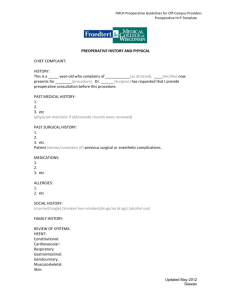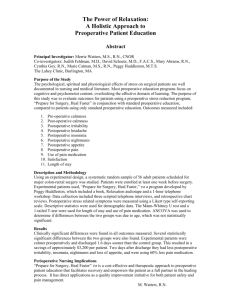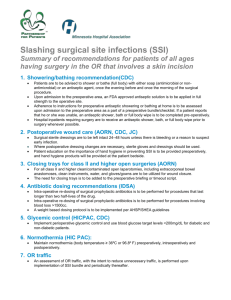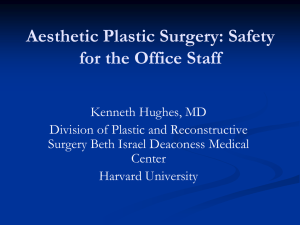Operations - TMA Department Sites
advertisement
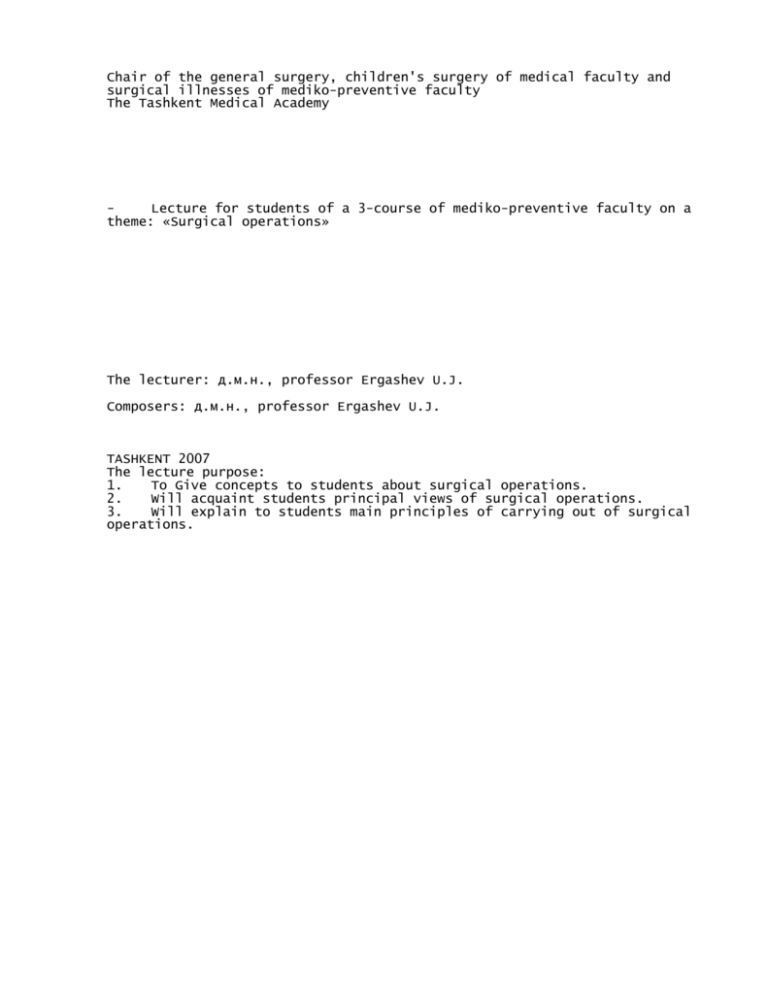
Chair of the general surgery, children's surgery of medical faculty and surgical illnesses of mediko-preventive faculty The Tashkent Medical Academy Lecture for students of a 3-course of mediko-preventive faculty on a theme: «Surgical operations» The lecturer: д.м.н., professor Ergashev U.J. Composers: д.м.н., professor Ergashev U.J. TASHKENT 2007 The lecture purpose: 1. To Give concepts to students about surgical operations. 2. Will acquaint students principal views of surgical operations. 3. Will explain to students main principles of carrying out of surgical operations. As Operation is called mechanical influence on fabrics and bodies with the medical or diagnostic purpose. Long year the word "operation" was a synonym of painful pains and danger of death. For surgery доантисептического the period the anatomic direction was characteristic. Absence of high-grade anaesthesia and blood transfusion, and also possibilities prevention раневой infections forced surgeons of that time to seize masterly technics what needed good knowledge of anatomy. Presently the operational risk has considerably decreased also surgery has accepted a physiological direction. It is reached by comprehensive investigation of the patient in the preoperative period, and also the subsequent dynamic supervision during operation and in the postoperative period. In modern surgery normal performance of operative intervention is provided, first of all, with corresponding decrease in pains that in turn, allows to eliminate excessive haste. Having found out changes in bodies and systems of the patient the surgeon in most cases possesses possibility in due time and considerably them to eliminate to provide efficiency of operative intervention. Classification of operations Depending on the operation provided by the purpose happen: 1. Diagnostic 2. Medical The radical The palliative On promptness: 1. Urgent or emergency 2. Urgent (ургентные) 3. Planned On этапности: 1. Odnoetapnye operations 2. Dvuhetapnye operations 3. Mnogoetapnye operations. On degree асептичности: 1. Pure operations 2. Is conditional-pure 3. Polluted 4. Dirty or initially The infected. Surgical operations are usually made with the medical purpose, also diagnostic operations however are applied. Punctures concern diagnostic operations (to a belly cavity, pleural, articulate, spinal, etc.), эндоскопические researches (цистоскопия, бронхоскопия, эзофагоскопия, гастроскопия, торакоскопия, a laparoscopy, etc.), ангиография and катетеризация hearts, diagnostic торакотомия and лапаротомия биопсии. Radical operations As radical operations are called such at which the amazed bodies or fabrics dissect or delete (аппендэктомия, a stomach resection), and possibility of relapse and repeated occurrence of disease are excluded. Radical operations can be expanded and combined (simultaneous removal of a spleen, a resection of a share of a liver and removal лимфоузлов at a sprouting tumour of a stomach in surrounding fabrics. Palliative operations do not liquidate an aetiology, but only facilitate conditions of the patient. So, for example, if the tumour closes a gleam of a thick gut and there is no possibility of its radical removal, resort to deducing of an intestinal loop on a forward wall of a stomach with the subsequent opening of its gleam. In that case the tumour remains, intestinal impassability and intestines contents however is eliminated freely allocated through каловый a fistula. Urgent operations are carried out immediately, at first two o'clock after hospitalisation of patients in a hospital and diagnosis specifications (an acute inflammation червеобразного a shoot of a blind gut, the stomach ulcer perforation, the restrained hernia, intestinal impassability). In certain cases - sharp bleedings, трахеостомия) it is necessary to make under vital indications in the nearest some minutes. Urgent operations are made in the first days after receipt in hospital because in process of fast development of process patients can become иноперабельными (malignant tumours, external intestinal fistulas, heavy congenital heart diseases). Planned operations are carried out at any time, and preparation for operative intervention can last one-two day, and in case of need within several weeks. In most cases operations are made in one stage (аппендэктомия, a stomach resection, a resection of a share of a lung, defect plastic межжелудочковой partitions). If the general conditions of the patient is estimated as heavy, and the operation volume is great and there is big enough degree of risk operation divide into two and more stages. For example, in the presence of extensive инфильтрата, arisen in connection with the limited inflammation червеобразного a shoot of a blind gut, at the first stage that the general peritonitis has not developed, open and дренируют периаппендикулярный an abscess, and аппендэктомию carry out in some months when inflammatory process will calm down. Example многоэтапной operations is creation of a migrating stalk on Filatovu at realisation of a skin plasticity of a skin plasticity, and also предгрудинная a plasticity of a gullet a small intestine or stage-by-stage removal extensive гемангиомы. Indications to operation happen: 1. Absolute. 2. Relative. 3. Vital. At absolute indications it is established that treatment of the given disease is possible only an operative way. Relative indications it is established when it is possible to apply other methods of therapy, though also less effective. Relative indications have, for example planned operations which it is possible to refuse temporarily without essential harm for health of the patient. At the same disease, depending on promptness, indications to operation can be both vital and absolute and relative. For example, at the complicated ulcer 12 перстной indication guts to operation can be vital (профузное a bleeding which is not giving in to a stop), or absolute (at the developed stenosis), or относительынми (when it was not made still all methods of conservative therapy). At definition of indications to operation in each specific case it is necessary to consider not only disease forecast, but also possibility of the operating surgeon, equipment and equipment of an operational hall which would provide successful performance of operation. The surgeon should not makes those operations with which it cannot is successful will consult, because the surgery is not sports, and the person is not object of experiments. The number of the spent operations in itself yet does not guarantee increase in surgical knowledge of the operator if it does not expand the experience, attentively assisting, or observing of a course of operations which it is carried out by more skilled колегами. In order to avoid unreasonable operations the surgeon should carefully will familiarise with patients, to think over the plan of operation and to make preoperative эпикриз in which are marked: 1. A diagnosis substantiation. 2. Indications to operation. 3. The operation plan. 4. An anaesthesia kind. Surgical operation is the difficult certificate in which three main stages differ: 1. The preoperative period and Preparation of the patient for operation. 2. Actually surgical operation. 3. Intensive supervision and care The patient in the postoperative The period. Maintenance of all above-stated stages guarantees effect of operational intervention. The preoperative period includes a time interval from the moment of receipt of the patient in a hospital or references in polyclinic prior to the beginning of operation. The preoperative period can be divided into two stages: 1) diagnosis specification. 2) preparation for operative intervention. At the first stage the diagnosis is specified, the condition of various bodies and systems is checked and indications to operation are defined, and on the second the patient prepare for operative intervention. In preparation for operation it is carried out actions for preventive maintenance of complications, correction of activity of the changed bodies for the purpose of increase of their functional reserves is carried out. The expanded radical operation demands the big reserves, rather than palliative operation, as well as, accordingly, многоэтапная and одноэтапная operation. In preoperative preparation for planned operations allocate: 1. The remote preoperative The period. 2. The nearest preoperative The period. 3. The direct preoperative The periods. So, for example, in the separated preoperative period at a craw or congenital heart diseases sanatorium treatment, sanitation миндалин and кариозных teeth is applied. In the nearest preoperative period (within 7-15 days) the general condition of somatic system is in due time normalised, and in direct preparation sanitary processing, evacuation of a contained bladder and a rectum is spent. Distinguish direct preoperative and specific actions. For direct preoperative actions uniformity and compulsion at a preparatory stage before any operation (hygienic water baths, shaving of hair, a cleaning enema, опорожнения a bladder) are characteristic. Specific actions it is spent for preparation for operations of a certain kind (evacuation of gastric contents at a stenosis of the gatekeeper, siphon washing of a thick gut before its resection, sanitation of bronchial tubes, in case of purulent diseases of lungs). Preoperative preparation joins also actions with which help is normalised or improves: 1) a mental condition of the patient. 2) the general somatic condition. 3) local process. Psychological preparation of patients includes: 1. Calm of the patient. 2. Struggle against a sleeplessness. 3. Reception of the consent of the patient on operation, for operation The child it is necessary the consent of parents. The general somatic preparation of patients includes: 1. Correction of changes in system Blood circulations. 2. Correction of changes in system Breath. 3. Anaemia liquidation. 4. Preventive maintenance of thromboses and эмболий. 5. Preparation of digestive system. 6. Preparation of urinogenital system. Local somatic preparation of patients includes: 1. Survey of an operational field on presence or absence Inflammatory changes. 2. Appointment a water bath and linen change. 3. Shaving of hair in the field of an operational field. Surgical operation shares on some stages: 1. Laying of the patient on an operational table. 2. Preparation of an operational field. 3. Anaesthesia. 4. Operative access. 5. Operation realisation. 6. Operation end. Position of the patient on an operational table: 1. Position on a back. 2. Position of Trendelenburga. 3. Lateral position. 4. Gynecologic position. 5. Position on a stomach. 6. A semisitting position of the patient (at перациях on back the cranial To pole). The operational field is that part of a body where operation is made. After processing of a skin in the field of an operational field of the patient cover with sterile operational linen, leaving opened only that site where the cut will be made. For отграничения an operational field apply the big and small bed-sheets, towels and napkins. At less considerable on volume including out-patient, operations local anaesthesia with which help reach loss of sensitivity of corresponding nervous receptors around intervention is more often applied. At operation under anaesthetic the operational field is prepared after narcosis approach because the patient in excitation can break sterility of an operational field. Operative access has rather great value. The accessible and convenient approach to the pathological centre facilitates realisation of operative intervention. At superficially located pathological processes - a section of a hypodermic abscess - access is rather wide, however the corner of operative action decreases in the heart of a wound. Operative access should be анатомически proved to provide minimum травматизацию fabrics. The postoperative period includes time from the termination of operation and until when at the patient work capacity or its condition is restored becomes steady and constant after the spent intervention. The postoperative period shares on three phases: 1. An early phase - the first 3-5 сут after operation 2. A late phase - 2-3 нед after operation, it is frequent till the extract moment From hospital. The remote phase - to restoration Work capacity. Operation for the patient - a physical and mental trauma. In the postoperative period proceed regenerative and репаративные the processes which are not observed in a healthy organism. Distinguish 1) the smooth or normal postoperative period and 2) the postoperative period with complications (complicated). In the first case moderately expressed reaction of an organism is observed, and in the second - sharply changed reaction to an operational trauma (гиперергическое or анергическое a condition) that causes the expressed functional changes in an organism and promotes development of postoperative complications.



